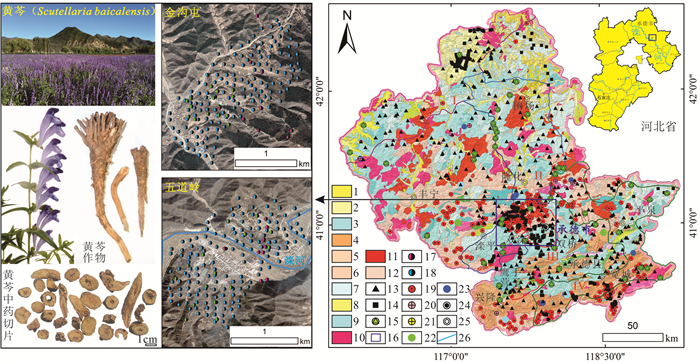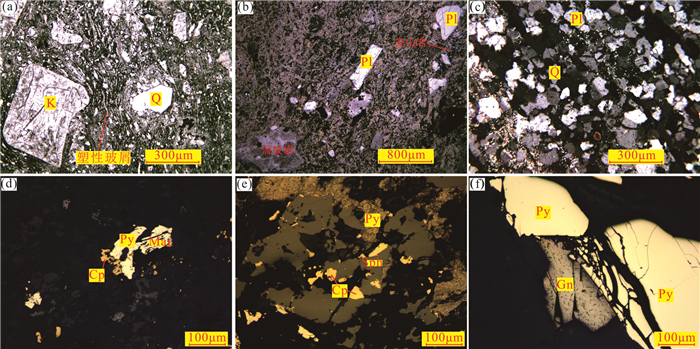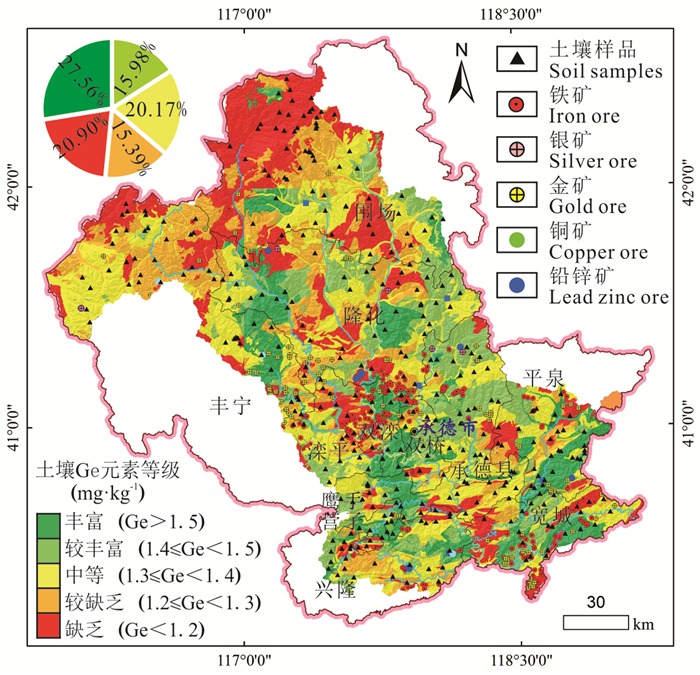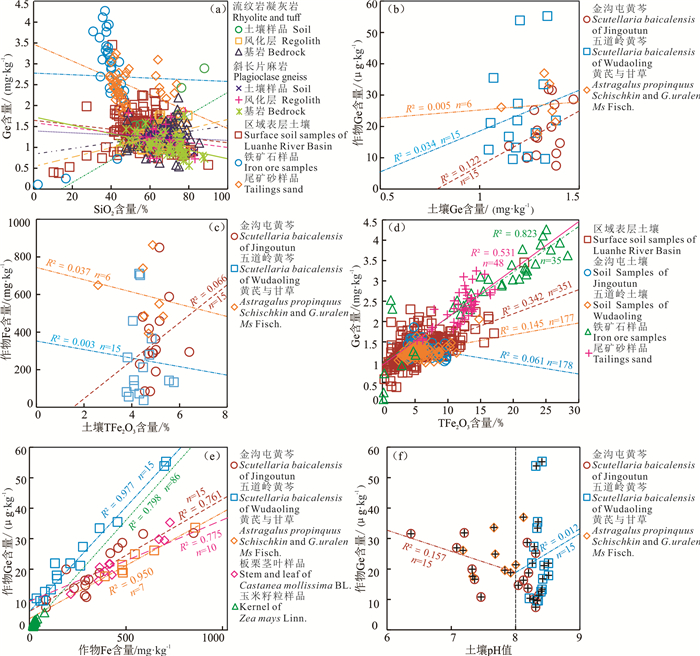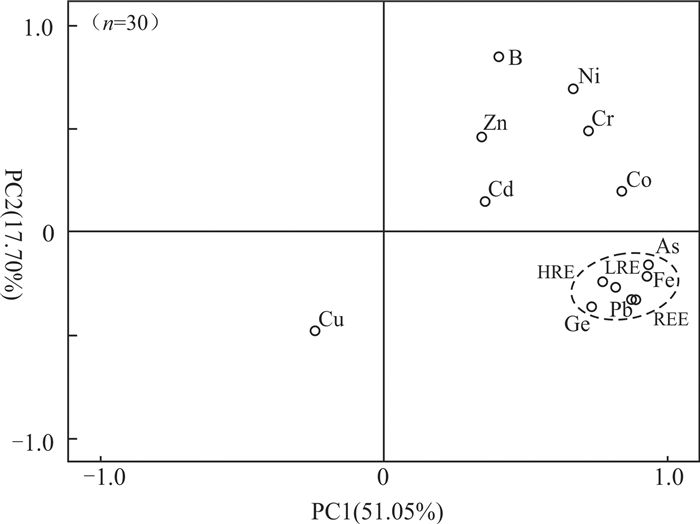The eco-geochemical characteristics of germanium and its relationship with the genuine medicinal material Scutellaria baicalensis in Chengde, Hebei Province
-
摘要:
道地药材生长与生态地球化学研究对实现中医药科学化和标准化具有重要意义。从承德市滦河流域与金沟屯和五道岭典型研究区阐明区域尺度和不同地质建造区Ge元素地球化学背景特征,结合多元统计采用基于Nb元素的质量迁移系数、化学蚀变指数CIA和残积系数RF、生物富集系数论述Ge元素在基岩-风化壳-土壤-黄芩系统中的迁移聚集规律,探讨Ge元素生态地球化学特征与道地药材黄芩的适生关系。结果表明:滦河流域表层土壤Ge元素平均含量为1.336 mg·kg-1,43.54%土壤样品Ge元素含量属丰富—较丰富水平;金沟屯和五道岭区表层土壤Ge元素平均含量分别为1.352 mg·kg-1和1.268 mg·kg-1。不同地质建造和表层土壤Ge元素含量与TFe2O3含量显著相关,土壤含铁矿物对Ge元素具有吸附作用。Ge元素含量随岩土风化程度升高而增大,金沟屯区土壤风化程度高于五道岭区,土壤成熟度相对较高,Ge元素富集程度相对较高。岩石风化过程中Ge元素与TFe2O3、V、Ti、Co、P、Pb、Cu、Zn、Al2O3、SiO2、K2O、Na2O质量迁移系数值相近,风化土壤与新鲜基岩Si和Ge含量发生明显分异,Ge元素主要来源于硅酸盐矿物风化过程中晶格破裂和金属硫化物矿物风化释放。金沟屯和五道岭黄芩Ge元素BCF平均值分别为0.014和0.020,黄芩根部对土壤Fe与Ge的吸收表现出明显的协同作用,土壤pH影响着Ge元素形态和生物有效性。区域土壤丰富的Fe、P和Sr元素含量为优质黄芩生长提供了有利条件;Fe族元素含量丰富,pH呈微碱性的沙壤质土壤为道地药材黄芩适宜生长和定向栽培种植区。
Abstract:The investigation of the relationship between the growth of genuine medicinal materials and eco-geochemical conditions is of great significance for the scientific development and standardization of traditional Chinese medicine. The geochemical background characteristics of Ge element in different geological formations and spatial scales were clarified in the regional scale of Luanhe River Basin and two Chinese herbal medicine planting demonstration areas of Jingoutun and Wudaoling. A multivariate statistical analysis method was used to analyze the eco-geochemical characteristics of germanium and its relationship with the genuine medicinal material Scutellaria baicalensis combined with mass transfer coefficient, chemical index of alteration, residual factor and bioconcentration factor. The results indicate that the average content of Ge element in the surface soil of Luanhe River Basin is 1.336 mg·kg-1, and the content of Ge element in 43.54% of soil samples was generally categorized as belonging to rich to abundant level, while the average content of Ge element in the surface soil of Jingoutun and Wudaoling area is 1.352 mg·kg-1 and 1.268 mg·kg-1. The Ge element content of different geological formations and surface soil is significantly related to the TFe2O3 content, and the iron-bearing minerals in the soil have an adsorption effect on the Ge element. The soil-regolith-rock samples with higher degree of weathering and maturity tend to have higher Ge content. The weathering degree and soil maturity of Jingoutun area is higher than that of Wudaoling area as well as the enrichment of Ge element. The mass transfer coefficient based on Nb of Ge element is similar to that of TFe2O3, V, Ti, Co, P, Pb, Cu, Zn, Al2O3, SiO2, K2O and Na2O. The ratio of Si/Ge changes significantly during the weathering process, which shows an antagonistic effect. The Ge element is mainly derived from the fracture of silicate mineral lattice and metal sulfide minerals released during their weathering process. The average bioconcentration factors of Ge element in Scutellaria baicalensis of Jingoutun and Wudaoling are 0.014 and 0.020 respectively. The root of Scutellaria baicalensis shows an obvious synergistic effect on the absorption of Fe and Ge in soil. The soil pH values have an important impact on the speciation and bioavailability of Ge element. The rich Fe, P and Sr values in the regional soil provide favorable conditions for the growth of high-quality Scutellaria baicalensis. The soil with abundant Fe group element content, slightly alkaline pH values and sand texture with better air permeability is suitable for the cultivation and growth of authentic Scutellaria baicalensis.
-
1. 引言
花岗岩是组成地球大陆地壳的重要岩石类型,是地球大陆地壳与地球大洋地壳乃至太阳系中其他类地行星的地壳相区别的最重要的标志(Pitcher, 1997)。花岗岩在大陆地壳增生和再循环的过程中起到了不可或缺的重要作用,在岩石圈构造演化、地球动力学和成矿作用研究中具有重要的意义(Barbarin,1999;李金东,2005;柏道远,2008;华仁民等, 2012, 2013;陈骏等,2014)。
华南加里东期花岗岩主要分布在湖南、江西、广西、广东和福建等省份,总面积超过2.2万km2(程顺波等,2013)。黄汲清早在1937年就提出华南可能存在加里东期花岗岩(黄汲清,1994)。徐克勤在1957年首先发现并证实华南存在加里东期花岗岩体(徐克勤等,1960)。此后,华南加里东期花岗岩逐渐引起地质界重视,吸引众多地质工作者加入到研究行列中(徐克勤等,1963;王德滋等,1978)。从20世纪80年代开始,随着地球化学、同位素地球化学分析方法和岩石定年方法的不断更新进步,对华南加里东期花岗岩的研究告别了单纯的经验判断;特别是到了90年代,随着高精度SHRIMP和LAICP-MS单颗粒锆石定年和锆石Lu-Hf同位素示踪技术的诞生,对华南加里东期花岗岩的研究有了强有力的科学技术支撑,研究水平不断提高。但是与华南燕山期花岗岩研究程度相比,华南加里东期花岗岩的研究明显不足,对其与成矿的关系认识不清,对其形成的构造背景的认识也存在很大的争议,目前主要有洋壳俯冲造山和板内挤压造山两种观点(孙明志等,1990;周新民等,2003;许德如等,2006;孙涛等,2006)。
苗儿山岩体位于湘西南和桂北交界处,为一个以加里东期花岗岩为主体,包括晋宁期、印支期和燕山期花岗岩的复式岩体,由于其构造岩浆活动强烈、形成时间跨度长,因此对于研究华南地区的花岗岩成因、成矿作用和大地构造演化具有重要的意义。另外,近几年针对苗儿山岩体的找矿工作连续取得较大突破,发现了多个大、中、小型钨(锡、钼、铜)矿床(刘伟等,2011;伍静等,2012;杜云等,2017),引起了越来越多学者的关注和研究。本文利用LA-ICP-MS单颗粒锆石U-Pb定年、X射线荧光光谱分析、高分辨等离子体质谱分析、Sr-Nd同位素分析和O同位素分析等高精度的分析测试手段,结合前人研究成果,对苗儿山岩体加里东期花岗岩的地球化学、锆石U-Pb年代学、Sr-Nd同位素和O同位素特征进行了系统研究,在此基础上,讨论加里东期花岗岩的形成构造背景和成因,可为华南地区花岗岩成岩理论研究的完善提供依据。
2. 岩体地质概况
苗儿山复式岩体位于湘西南与桂北交界处,总出露面积约1600 km2,其北段处于湖南省境内,呈南北向展布,出露面积约450 km2,南段主要位于广西区境内,呈北东向展布。苗儿山复式岩体由加里东期花岗岩构成主体,晋宁期、印支期和燕山期花岗岩呈小岩株状广泛分布其中,构成补体(图 1)。
![]() 图 1 大地构造位置(a)和区域地质略图(b)1—白垩系;2—泥盆系至三叠系;3—寒武系至奥陶系;4—新元古界青白口系至震旦系;5—燕山期花岗岩;6—印支期花岗岩;7—加里东期花岗岩;8—新元古代晋宁期花岗闪长岩;9—地质界线;10—断层;11—U-Pb年龄样采样位置及编号;12—研究区范围Figure 1. Tectonic location(a) and regional geological map(b)1-Cretaceous system; 2-Devonian system to Triassic system; 3-Cambrian system to Ordovician system; 4-Neoproterozoic Qingbaikou system to Sinian system; 5-Yanshanian granite; 6-Indosinian granite; 7-Caledonian granite; 8-Neoproterozoic Jinningian granodiorite; 9-Geological boundary; 10-Fault; 11-U-Pb age sampling location and numbering; 12-The study area
图 1 大地构造位置(a)和区域地质略图(b)1—白垩系;2—泥盆系至三叠系;3—寒武系至奥陶系;4—新元古界青白口系至震旦系;5—燕山期花岗岩;6—印支期花岗岩;7—加里东期花岗岩;8—新元古代晋宁期花岗闪长岩;9—地质界线;10—断层;11—U-Pb年龄样采样位置及编号;12—研究区范围Figure 1. Tectonic location(a) and regional geological map(b)1-Cretaceous system; 2-Devonian system to Triassic system; 3-Cambrian system to Ordovician system; 4-Neoproterozoic Qingbaikou system to Sinian system; 5-Yanshanian granite; 6-Indosinian granite; 7-Caledonian granite; 8-Neoproterozoic Jinningian granodiorite; 9-Geological boundary; 10-Fault; 11-U-Pb age sampling location and numbering; 12-The study area苗儿山复式岩体出露于苗儿山复式背斜核部,其中加里东期花岗岩构成的主体与前泥盆纪地层呈侵入接触关系,而与泥盆系、白垩系则呈沉积接触关系。前泥盆纪地层主要包括青白口系、南华系、震旦系和奥陶系(缺失志留系),为一套浅海—半深海相类复理石砂泥质碎屑沉积夹硅质、炭泥质沉积,部分层位夹碳酸盐岩;泥盆系为滨浅海碎屑岩—浅海台地、台盆相碳酸盐岩沉积;白垩系为陆相红盆碎屑沉积。苗儿山岩体及其四周围岩中断裂十分发育,其中NNE—NE向断裂规模最大,数量最多,构造形迹非常醒目,所谓的“城步—江口大断裂”,即为该组出露总宽度达数十千米的断裂的统称,它控制了苗儿山岩体的空间展布,并在多次继承性活动中对苗儿山岩体造成了明显的切割破坏作用。
3. 岩石学特征
按地球化学、同位素年代学及野外地质特征,加里东期花岗岩从早到晚可分为六个侵入次,分别为第一侵入次中细粒斑状黑云母二长花岗岩(ηγSa)、第二侵入次中粗粒斑状黑云母二长花岗岩(ηγSb)、第三侵入次中粒斑状黑云母二长花岗岩(ηγSc)、第四侵入次中细粒黑云母二长花岗岩(ηγSd)、第五侵入次细粒斑状黑云母二长花岗岩(ηγSe)、第六侵入次细粒黑云母二长花岗岩(ηγSf)。各个侵入次之间均为侵入接触关系,具有较为明显的分界线(图 2a、b)。
![]() 图 2 加里东期不同侵入次花岗岩之间的典型接触特征a—第五侵入次花岗岩侵入于第四侵入次花岗岩中;b—第六侵入次花岗岩侵入于第五侵入次花岗岩中Figure 2. Representative contacts between the different episodes of Caledonian granitesa-A representative photo of the fifth episodic granites intruding into the fourth episodic granites; b-A representative photo of the sixth episodic granites intruding into the fifth episodic granites
图 2 加里东期不同侵入次花岗岩之间的典型接触特征a—第五侵入次花岗岩侵入于第四侵入次花岗岩中;b—第六侵入次花岗岩侵入于第五侵入次花岗岩中Figure 2. Representative contacts between the different episodes of Caledonian granitesa-A representative photo of the fifth episodic granites intruding into the fourth episodic granites; b-A representative photo of the sixth episodic granites intruding into the fifth episodic granites第一侵入次中细粒斑状黑云母二长花岗岩(ηγSa),主要由粒径10~30 mm的自形—半自形板状钾长石为斑晶(含量10%~30%)和粒径0.7~4.4 mm的他形石英、钾长石、半自形板状斜长石、片状黑云母、菱柱状角闪石等为基质(含量70%~90%)组成,构成似斑状结构,基质为中—细粒花岗结构(图 3a、b)。钾长石含量31%~45%,他形为主,具条纹结构、格子双晶,表面见石英、斜长石、黑云母等嵌晶。斜长石含量18%~29%,半自形板柱状,强绢云母化,发育聚片双晶,部分显环带构造。石英含量28%~33%,他形粒状、粒状集合体状,与长石互嵌或填隙长石粒间,微区可见石英呈文象状嵌布在钾长石中。黑云母含量4%~11%,片状、片状集合体状,褐色,含磷灰石、锆石、绿帘石等包体。角闪石含量微至1%,菱柱状,绿色,分散分布或包嵌于钾长石中。副矿物主要有金红石、磷灰石、锆石、绿帘石和黄铁矿,含少量方铅矿和磁铁矿。第一侵入次中可见少量暗色微粒包体,包体多呈不规则状或椭圆状,与围岩界线截然,直径一般在2~10 cm(图 3c)。包体具似斑状结构,块状构造。斑晶含量约4%,主要为斜长石斑晶,直径1.5~3 mm。基质含量约96%,具半自形粒状结构,颗粒间紧密镶嵌,主要由主要由斜长石(44%)、黑云母(30%)和石英(19%) 组成,含少量磷灰石(2%),及微量锆石(图 3d)。黑云母,棕褐色,自形—半自形板片状,部分可见针状金红石沿解理缝析出;石英,他形粒状,粒径约0.2~0.96 mm;磷灰石,无色,细小针柱状;锆石,无色粒状,粒径约0.2 mm。暗色微粒包体的岩性与寄主岩的岩性特征有显著差异,主要表现在颜色明显较深,矿物粒度明显较细,不含钾长石,斜长石和黑云母含量显著增加,石英含量明显减少。由于暗色微粒包体由两期先后结晶的矿物构成,具有明显的火成结构,且其组成矿物主要为斜长石、黑云母和石英,与火成岩、沉积岩部分熔融残余物(Tindle and Pearce, 1982)和壳幔混合成因的镁铁质微粒包体(MME)几乎不含石英的特征明显不同(Barbarin,2005),因此应该既不是地壳部分熔融过程中形成的耐熔残余物,也不是壳幔混合的产物,而是地壳中偏基性的岩石的熔融物,反映了地壳源区成分的不均一性。
![]() 图 3 加里东期第一、三侵入次花岗岩及包体的照片和显微照片a—第一侵入次花岗岩露头;b—第一侵入次花岗岩显微照片;c—细粒暗色包体手标本;d—细粒暗色包体显微照片;e—第三侵入次花岗岩露头;f—第三侵入次花岗岩显微照片Figure 3. Representative photographs and photomicrographs of the first and third episodic granites and enclaves from the Miao'ershan plutona-A representative outcrop of the first episodic granites; b-A representative photomicrograph of the first episodic granites; c-A representative hand specimen of the fine-grained dark enclaves; d-A representative photomicrograph of the fine dark enclaves; e-A representative outcrop of the third episodic granites; f-A representative photomicrograph of the third episodic granites
图 3 加里东期第一、三侵入次花岗岩及包体的照片和显微照片a—第一侵入次花岗岩露头;b—第一侵入次花岗岩显微照片;c—细粒暗色包体手标本;d—细粒暗色包体显微照片;e—第三侵入次花岗岩露头;f—第三侵入次花岗岩显微照片Figure 3. Representative photographs and photomicrographs of the first and third episodic granites and enclaves from the Miao'ershan plutona-A representative outcrop of the first episodic granites; b-A representative photomicrograph of the first episodic granites; c-A representative hand specimen of the fine-grained dark enclaves; d-A representative photomicrograph of the fine dark enclaves; e-A representative outcrop of the third episodic granites; f-A representative photomicrograph of the third episodic granites第二侵入次中粗粒斑状黑云母二长花岗岩(ηγSb),主要由粒径8~40 mm的自形—他形钾长石、斜长石、石英为斑晶(含量10%~20%)和粒径2~7mm的他形钾长石、石英、半自形板状斜长石、片状黑云母等为基质(含量80%~90%)组成,构成似斑状结构,基质为中—粗粒花岗结构。钾长石含量34%~48%,他形为主,具条纹结构、格子双晶,表面见石英、斜长石、黑云母等嵌晶。斜长石含量18%~38%,半自形板柱状,绢云母化、黏土化,发育聚片双晶,部分显环带构造。石英含量22%~35%,他形粒状、粒状集合体状,与长石互嵌或填隙长石粒间。黑云母含量约3%~6%,片状、细片集合体状,绿泥石化,解理缝析出钛铁质,生成绿帘石,含磷灰石包体。副矿物主要有金红石、磷灰石、锆石、绿帘石、黄铁矿和方铅矿,含少量黄铜矿和磁铁矿。
第三侵入次中粒斑状黑云母二长花岗岩(ηγSc),主要由粒径8~35 mm的自形—半自形板状钾长石为斑晶(含量10%~20%)和粒径2~5 mm的他形钾长石、石英、半自形板状斜长石、片状黑云母、细柱状帘石等为基质组成,构成似斑状结构,基质为中粒花岗结构(图 3e、f)。钾长石含量28%~50%,他形为主,具条纹结构、格子双晶,表面碎裂,裂隙中充填帘石、微晶石英等。斜长石含量18%~29%,半自形板柱状,强绢云母化,发育聚片双晶,部分显环带构造。石英含量28%~33%,他形粒状、粒状集合体状,与长石互嵌,部分细粒化重结晶的石英分布于石英或长石微裂隙中。黑云母含量4%~11%,片状、片状集合体状,绿泥石化,解理缝析出钛铁质,生成绿帘石,含磷灰石包体。绿帘石含量微至2%,柱状、柱粒状,主要与黑云母共生或分布在岩石微裂隙中。副矿物主要有金红石、磷灰石、锆石、绿帘石和黄铁矿,含少量方铅矿和磁铁矿。
第四侵入次中细粒黑云母二长花岗岩(ηγSd),主要由粒径0.5~3.6 mm的他形—半自形钾长石、半自形板状斜长石、它形粒状石英、片状黑云母等互相镶嵌组成,构成中细粒花岗结构。钾长石含量25%~43%,他形为主,隐显条纹结构、格子双晶,碎裂,具微裂隙,裂隙中充填氧化铁质物,表面嵌圆粒化石英、斜长石、黑云母等。斜长石含量20%~45%,半自形-自形板条状,绢云母化,发育聚片双晶。石英含量29%~33%,他形粒状、粒状集合体状,具微裂隙,裂隙中充填氧化铁质物,嵌微晶长石。黑云母含量6%~8%,片状、片状集合体状,弱绿泥石化,解理缝析出铁质,生成绿帘石,含磷灰石包体。副矿物主要有金红石、磷灰石、锆石、绿帘石和黄铁矿,含少量方铅矿和磁铁矿。
第五侵入次细粒斑状黑云母二长花岗岩(ηγSe),主要由粒径4~8 mm的自形—半自形板状钾长石、斜长石为斑晶(含量5%~20%)和粒径0.18~2.18 mm的他形石英、钾长石、自形—半自形板状斜长石、片状黑云母及少量片状白云母、碎粒状电气石等为基质(含量80%~95%)组成,构成似斑状结构,基质为细粒花岗结构(图 4a、b)。钾长石含量20%~35%,他形为主,具条纹结构、格子双晶,见较多石英、长石包裹体。斜长石含量25%~33%,半自形板柱状,弱—中等程度绢云母化,发育聚片双晶,部分显环带构造。石英含量20%~30%,他形粒状、粒状集合体状,晶粒切面上具明显的波状消光和显微裂缝。黑云母含约6%~8%,片状、片状集合体状,绿泥石化,解理缝析出铁质,生成绿帘石、榍石,含磷灰石、锆石等包体。白云母含量微至1%,片状,星散分布或与黑云母共生。电气石含量微至1%,碎粒状,具电气石式吸收,零散分布。副矿物主要有金红石、磷灰石、锆石、绿帘石、黄铁矿和方铅矿,含少量磁铁矿和榍石。
![]() 图 4 加里东期第五、六侵入次花岗岩的照片和显微照片a—第五侵入次花岗岩露头; b—第五侵入次花岗岩显微照片; c—第六侵入次花岗岩手标本; d—第六侵入次花岗岩显微照片Figure 4. Representative photographs and photomicrographs of the fifth and sixth episodic granites and enclaves from the Miao'ershan plutona-A representative outcrop of the fifth episodic granites; b-A representative photomicrograph of the fifth episodic granites; c-A representative outcrop of the sixth episodic granites; d-A representative photomicrograph of the sixth episodic granites
图 4 加里东期第五、六侵入次花岗岩的照片和显微照片a—第五侵入次花岗岩露头; b—第五侵入次花岗岩显微照片; c—第六侵入次花岗岩手标本; d—第六侵入次花岗岩显微照片Figure 4. Representative photographs and photomicrographs of the fifth and sixth episodic granites and enclaves from the Miao'ershan plutona-A representative outcrop of the fifth episodic granites; b-A representative photomicrograph of the fifth episodic granites; c-A representative outcrop of the sixth episodic granites; d-A representative photomicrograph of the sixth episodic granites第六侵入次细粒黑云母二长花岗岩(ηγSf),主要由粒径0.2~2 mm的细粒他形钾长石、石英、半自形板状斜长石、片状黑云母及少量碎粒状电气石、片状白云母等组成,构成细粒花岗结构(图 4c、d)。钾长石含量28%~44%,他形为主,具条纹结构,与石英互嵌。石英含量32%~34%,他形粒状、粒状集合体状,与长石互嵌或填隙长石粒间。斜长石含量20%~40%,半自形板柱状,绢云母化、黏土化,发育聚片双晶。黑云母含量2%~5%,片状、细片集合体状,绿泥石化,解理缝析出铁质,生成绿帘石,含磷灰石包体。电气石含量微至3%,碎粒状,具电气石式吸收,零散分布,局部富集形成电气石团块或细脉。白云母含量微至1%,片状,星散分布或与黑云母共生。副矿物主要有金红石、磷灰石、锆石和方铅矿,含少量绿帘石、黄铁矿、磁铁矿及富铝矿物石榴子石。
加里东期六个侵入次的岩性特征表明,加里东期花岗岩从早期到晚期,矿物颗粒的粒度逐渐减小,暗色矿物黑云母总体逐渐降低,角闪石从有到无,电气石、白云母和石榴子石从无到有,反映随着岩浆的演化,镁铁质成分逐渐减少,酸性程度逐渐增大,挥发份含量也逐渐提高。
4. 样品处理与分析方法
岩石地球化学分析:包括主量、微量和稀土元素分析,分析方法为先将新鲜样品粉碎、研磨至200目,再采用高精度的专业仪器进行测试,所有分析测试工作均在中国科学院地球化学研究所完成。其中主量元素测试方法为X射线荧光光谱法(XRF),测试仪器为Axios(PW4400)X射线荧光光谱仪;微量和稀土元素测试方法电感耦合等离子体质谱法(ICP-MS),测试仪器为Finnigan MAT公司ELEMENT型高分辨等离子体质谱仪。
锆石U-Pb在中国科学院地球化学研究所矿床地球化学国家重点实验室完成。先将样品破碎、筛选、重选及磁选,在双目镜下挑选出透明度较好、晶形完整、无明显裂隙的锆石颗粒,再将锆石制成锆石样品靶,利用阴极荧光谱仪对锆石样品靶进行锆石显微照相,然后在此基础上进行锆石的U-Pb同位素测定工作。分析仪器为Perkinelmer生产的ELAN DRC-e型等离子质谱仪。原始测试数据用ICPMSDataCal软件进行处理(Liu et al., 2008)。普通Pb校正方法参照Andersen(2002),206Pb/238U加权平均年龄及谐和图解采用ISOPLOT软件制作(Ludwig,2003)。
Sr-Nd同位素分析在南京大学内生金属矿床成矿机制研究国家重点实验室完成,测试仪器为德国Thremo Fisher Scientific公司生产的Triton型热电离同位素质谱仪。Sr-Nd同位素分析采用Teflon溶样器,加NHO3和HF混合溶样,用专用的阳离子交换柱进行分离,分别采用86Sr/88Sr =0.1194和146Nd/144Nd=0.7219对Sr和Nd同位素进行分馏校正。在本次测试中,仪器测定的Sr同位素国际标准样品NBS987的87Sr/86Sr比值为0.710254±16(2σ),岩石标样BCR-1中的143Nd/144Nd比值为0.512638±3 (2σ)。Rb-Sr和Sr-Nd的全流程本底分别为小于100 pg和50 pg。
氧同位素分析:在中国地质科学院地质研究所完成,测试仪器为MAT-253气体同位素质谱计,δ18O全流程分析误差分别优于±3‰和±0.2‰。首先采用无污染玛瑙球磨技术将样品粉碎至 < 200目,再采用BrF5法提取样品中的氧,然后将氧与碳棒反映转化成CO2,再对样品中的氧同位素进行质谱测定。分析结果均以相对于SMOW(全球标准平均大洋水) 同位素比值的千分变化值表示。
5. 地球化学特征
5.1 主量元素特征
加里东期花岗岩主量元素化学分析结果、CIPW标准矿物计算及有关岩石化学分析参数见表 1。
表 1 加里东期花岗岩主量元素组成(%)及部分特征参数Table 1. Major element composition (%) and some characteristic parameters of the Caledonian granites
加里东期花岗岩侵入次较多,为了便于阐述,本文将其按照矿物和化学成分特征分为早、中、晚三期,其中早期包括第一侵入次,中期包括第二、三、四、五侵入次,晚期包括第六侵入次。加里东期花岗岩SiO2含量高,且变化范围大,为67.96%~75.99%,平均72.65%,其中早期花岗岩SiO2含量为67.96%~73.37%,平均70.92%;中期花岗岩SiO2含量为70.54%~75.99%,平均72.90%;晚期花岗岩SiO2含量为72.94%~74.55%,平均73.74%;表明从早期到晚期SiO2含量具有逐渐升高的趋势。Al2O3含量高,为12.4%~14.86%,平均13.29%;其中早期花岗岩Al2O3含量为12.93%~14.47%,平均13.44%;中期花岗岩Al2O3含量为12.26%~14.86%,平均13.38%;晚期花岗岩Al2O3含量为12.40%~14.04%,平均13.06%;表明从早期到晚期Al2O3含量变化不大,仅显示出略微降低的趋势。全碱(ALK)含量高,(Na2O+K2O)绝大多数都在6.71%~9.62%(D0026和D0032两个样品的ALK含量分别为9.62%和12.23%,显著高于其他样品,明显是后期碱交代作用的结果),平均8.53%;K2O含量较高,为3.43%~5.56%,平均4.58%;K2O/Na2O比值较大,为0.83~2.0,平均1.23,与华南壳源花岗岩K2O/ Na2O比值大于1的特征明显相符,显示出壳源S型花岗岩的特征(凌洪飞等,2005)。早期花岗岩的全碱(ALK)、K2O及Na2O含量分别为7.82%、4.19%和3.63%;中期花岗岩的全碱(ALK)、K2O及Na2O含量分别为8.81%、4.49%和3.69%;晚期花岗岩的全碱(ALK)、K2O及Na2O含量分别为9.52%、4.99%和4.53%;表明从早期到晚期全碱(ALK)、K2O及Na2O的含量都有逐渐升高的趋势。TFeO含量较低,为0.46%~3.60%,平均1.59%;MgO含量较低,为0.17%~1.39%,平均0.52%。其中早期花岗岩的TFeO和MgO的平均含量分别为2.30%和0.89%;中期花岗岩的TFeO和MgO的平均含量分别为1.54%和0.50%;晚期花岗岩的TFeO和MgO的平均含量分别为1.08%和0.24%;表明从早期到晚期TFeO和MgO有逐渐降低的趋势,反映岩浆向着铁镁质成分降低、酸性程度增大的方向演化。TiO2、MnO、CaO、P2O5含量较低,多在1%以下,且从早期到晚期具有含量逐渐降低的趋势。综上,主量元素的规律性变化,表明从早期到晚期,加里东期花岗岩一直向着富硅、富碱、贫铁镁质的方向演化,且其结晶分异程度不断增高。
加里东期花岗岩的分异指数(DI)介于78.35~96.37,平均90.78,远大于未经分异的原生基性岩浆的DI值(DI=25~45,朴成哲,2016);早期、中期、晚期花岗岩的平均DI值分别为85.83、91.58、93.80。固结指数(SI)介于1.68~11.78,平均4.75,小于未经分异的原生基性岩浆的SI值(SI=25~45,朴成哲,2016);早期、中期、晚期花岗岩的平均SI值分别为7.93、4.78、2.18。分异指数和固结指数表明加里东期花岗岩是经过充分结晶分异的产物,并且具有从早期到晚期结晶分异程度不断增高的特征。
CIPW标准矿物计算表明,加里东期花岗岩样品中大多数都出现刚玉,C值为0.12~3.03,平均1.05,总体显示出铝过饱和的特征。另外,D0026和D0032两个样品的CIPW标准矿物中还出现了锥辉石和硅酸钠两种碱性矿物,反映这2个样品均为碱过饱和花岗岩,结合这两个样品ALK值偏大,A/CNK值和C值偏小等特征,推断这2个样品受到了显著的后期碱交代作用。
在SiO2-(K2O+Na2O)图解中,加里东期花岗岩样品基本都落入花岗岩区,仅有1个早期花岗岩的样品落入花岗闪长岩区,表明加里东期花岗岩总体属酸性岩浆岩(图 5)。铝饱和度(A/CNK)介于0.98~1.31,平均1.09(D0026和D0032两个样品A/CNK值分别为0.85和0.70,远小于1,受到后期碱交代的影响,不计入平均值),总体属过铝质花岗岩(Sylvester et al., 1998;Chappell and White, 2001;肖庆辉等,2002)。
![]() 图 5 加里东期花岗岩SiO2-(K2O+Na2O)图解Figure 5. SiO2-(K2O+Na2O) diagram of the Caledonian granites(after Middlemost, 1994)
图 5 加里东期花岗岩SiO2-(K2O+Na2O)图解Figure 5. SiO2-(K2O+Na2O) diagram of the Caledonian granites(after Middlemost, 1994)根据Frost et al. (2001)提出的地球化学分类法,花岗岩可以通过Fe数(TFeO/(TFeO+MgO))、改良碱钙指数(Na2O+K2O-CaO)和铝饱和指数(ASI) (Al/(Ca-1.67P+Na+K))这三个地球化学变量加以有效区分。投图结果显示,加里东期花岗岩总体属铁质-镁质(早期偏向镁质,晚期偏向铁质)、碱钙性-钙碱性、弱过铝-强过铝质花岗岩(图 6a~c)。另外,在SiO2-K2O图解中,加里东期花岗岩样品绝大多数都落入高钾钙碱性系列范围,总体属高钾钙碱性系列(图 6d)。
![]() 图 6 加里东期花岗岩地球化学分类图解(图例同图 4)Figure 6. Geochemical classification diagram of the Caledonian granites(a—c, after Frost et al., 2001; d, after Peccerillo et al., 1976)
图 6 加里东期花岗岩地球化学分类图解(图例同图 4)Figure 6. Geochemical classification diagram of the Caledonian granites(a—c, after Frost et al., 2001; d, after Peccerillo et al., 1976)5.2 微量元素特征
在不相容元素对原始地幔标准化蛛网图上(图 7a),加里东期花岗岩样品的元素分布特征总体一致,各样品的Ba、Nb、Sr、P、Ti元素均表现为明显的亏损,其中Ba、Sr、Ti亏损最为显著,呈深“V”型,而(Rb+K)、(Th+U)、(La+Ce)、Nd、(Zr+Hf+Sm)、(Y+ Yb+Lu)等则相对富集,显示出壳源花岗岩的特征。Sr、Ba亏损一般与斜长石熔融残留或结晶分离作用有关(Patino Douce et al., 1991, 1995)。P、Ti亏损可能与磷灰石、钛铁矿的分离结晶作用有关。Nb的亏损表明源区岩石中以陆壳组分为主(Green,1995;Barth et al., 2000)。
![]() 图 7 加里东期花岗岩微量元素原始地幔标准化蛛网图(a)与稀土元素球粒陨石标准化分布型式图(b)(原始地幔值据Sun and McDonough, 1989;球粒陨石值据Taylor and Mclennan, 1985)Figure 7. Primitive mantle-normalized trace elements spider diagram (a) and chondrite-normalized REE distribution panttern diagram (b) of the Caledonian granites(Primitive mantle value is after Sun and McDonough, 1989; Chondrite value is after Taylor and Mclennan, 1985)
图 7 加里东期花岗岩微量元素原始地幔标准化蛛网图(a)与稀土元素球粒陨石标准化分布型式图(b)(原始地幔值据Sun and McDonough, 1989;球粒陨石值据Taylor and Mclennan, 1985)Figure 7. Primitive mantle-normalized trace elements spider diagram (a) and chondrite-normalized REE distribution panttern diagram (b) of the Caledonian granites(Primitive mantle value is after Sun and McDonough, 1989; Chondrite value is after Taylor and Mclennan, 1985)高场强元素中Nb与Ta、Zr与Hf的原子价和原子半径相同,化学性质极为相似,一般情况下彼此难分离。但壳、幔分离时,Nb、Ta分别优先进入地幔和地壳,使得Nb、Ta分别在地幔和地壳中富集,因此Nb/Ta比可用来示踪火成岩岩浆形成时地壳组分的参与程度(Green,1995)。岩石微量元素丰度及部分特征参数计算结果表明(表 2),加里东期花岗岩Nb/Ta比值介于3.36~9.89之间,平均5.41,低于地壳的平均值12.22(Rudniek and Fountain, 1995)及原始地幔平均值17.4(Sun and McDonough, 1989),说明其属壳源成因类型(陈小明等,2002)。Zr/Hf比值(18.40~35.61,平均24.55),不仅低于中国东部(36.72,高山等,1999) 上地壳平均值和全球地壳平均值(86.67,黎彤,1976),也低于原始地幔平均值(29.64,Taylor and McLennan, 1985),意味着可能在岩浆演化过程中Zr/Hf发生了较明显的分馏。
表 2 加里东期花岗岩微量元素丰度(Ag为10-9;其余为10-6)Table 2. Trace element abundance of the Caledonian granites (Ag: 10-9, the other elements: 10-6)
部分大离子亲石元素和高场强元素的比值可以示踪岩浆岩物质来源。Rb/Sr比值(变化范围大,为1.55~30.34,平均12.08)远高于中国东部(0.31,高山等,1999)和全球(0.32,Taylor and MeLennan, 1985)上地壳的平均值,Rb/Nb比值(8.10~26.92平均15.20)高于中国东部(6.8,高山等,1999)以及全球(4.5,Taylor and McLennan, 1985)上地壳的平均值,反映加里东期花岗岩具有高成熟度的壳源成因的特征(Harris and Inger, 1992;李献华等,2002)。Rb/Sr比值高,且变化范围大,除岩浆本身因为高度分异而具有富Rb贫Sr的特征外,可能也如前述主量元素特征所反映的一样,部分样品后期发生了不同程度的碱交代作用导致了Rb的富集。
5.3 稀土元素特征
岩石稀土元素丰度及部分特征参数计算结果表明(表 3),加里东期花岗岩稀土总量基本都介于46.60×10-6~198.42×10-6(仅1个为344.12×10-6),变化较大,平均128.22×10-6,小于地壳165.35×10-6的平均含量,但远高于上地幔17.48×10-6的平均含量(黎彤等,1976)。轻重稀土总和比值(ΣLREE/ΣHREE)较大,介于2.50~13.74,平均5.66,反映轻、重稀土分馏明显,轻稀土较为富集。(La/Sm)N值介于1.90~18.74,变化大,平均5.84,由于(La/Sm)N值越大,反映轻稀土(LREE)越富集,(La/Sm)N值大于1,即为轻稀土富集型(韩吟文等,2003),因此加里东期花岗岩属于典型的轻稀土富集型花岗岩。δEu值介于0.09~0.42,平均0.21,显示铕具有明显的亏损,表明斜长石大量存在于部分熔融残余体中或斜长石在岩浆作用过程中发生了显著的分离结晶作用(Visonà and Lombardo,2002)。
表 3 加里东期花岗岩稀土元素丰度(10-6)及有关参数Table 3. REE abundance (10-6) and its related parameters of the Caledonian granites
加里东期不同侵入次的花岗岩在(La/Sm)N和δEu值方面表现出一定的差异性。早期花岗岩(La/Sm)N值介于2.83~11.72,平均7.33;δEu值介于0.1~0.42,平均0.28。中期花岗岩(La/Sm)N值介于2.87~18.74,平均7.04;δEu值介于0.14~0.39,平均0.25。晚期花岗岩(La/Sm)N值介于1.9~6.12,平均3.20;δEu值介于0.09~0.13,平均0.12。上述事实表明从早期到晚期,加里东期花岗岩(La/Sm)N和δEu值逐渐减小,分异演化特征较为明显。
在稀土元素配分型式图(图 7b)中,加里东期花岗岩变化特征基本一致,总体为向右倾斜曲线,均出现铕的低谷。其中,轻稀土一侧的曲线较陡,重稀土一侧的曲线十分平缓,表明轻稀土发生了显著的分馏作用,而重稀土没有发生明显的分馏作用。
6. 锆石U-Pb年代学特征
本次共对加里东期花岗岩采集了4个锆石U-Pb测年样品,其中D0026采自加里东期第一侵入次中细粒斑状黑云母二长花岗岩,D0029和D0035采自加里东期第二侵入次中粗粒斑状黑云母二长花岗岩,D0070采自加里东期第六侵入次细粒黑云母二长花岗岩。
从4个样品中所获锆石颗粒较大,粒径50~300 μm,自形程度高,多为自形柱状,颜色以褐色、浅褐色为主,透明到半透明,阴极发光图像(图 8)均显示清晰的韵律环带结构,且Th/U值高,为0.17~1.44,皆大于0.1,应为典型的岩浆结晶锆石(周剑雄等,2007)。
样品D0026共分析了12颗锆石,分析结果见表 4。12个测点的年龄集中在427.1~428.6 Ma,加权平均年龄为(428.1±3.6)Ma,MSWD=0.0039(图 9a),误差小,精度高,可靠性大,代表了加里东期第一侵入次岩体的形成年龄。
表 4 加里东期花岗岩样品D0026锆石U-Pb定年结果Table 4. Zircon U-Pb dating results for the sample D0026 of Caledonian granite
样品D0029共分析了12颗锆石,分析结果见表 5。12个测点的年龄集中在419.4~420.8 Ma,加权平均年龄为(420.3±3.4)Ma,MSWD=0.0035(图 9b),误差小,精度高,可靠性大,代表了加里东期第二侵入次岩体的形成年龄。
表 5 加里东期花岗岩样品D0029锆石U-Pb定年结果Table 5. Zircon U-Pb dating results for the sample D0029 of Caledonian granite
样品D0035共分析了16颗锆石,分析结果见表 6。16个测点的年龄集中在420.1~421.9 Ma,加权平均年龄为(421.3±3.2)Ma,MSWD=0.0038(图 9c),误差小,精度高,可靠性大,代表了加里东期第二侵入次岩体的形成年龄。
表 6 加里东期花岗岩样品D0035锆石U-Pb定年结果Table 6. Zircon U-Pb dating results for the sample D0035 of Caledonian granite
样品D0070共分析了14颗锆石,分析结果见表 7。其中14个测点的年龄集中在407.7~408.9 Ma之间,加权平均年龄为(408.3±3.5)Ma,MSWD=0.0024 (图 9d),误差小,精度高,可靠性大,代表了加里东期第六侵入次岩体的形成年龄。
表 7 加里东期花岗岩样品D0070锆石U-Pb定年结果Table 7. Zircon U-Pb dating results for the sample D0070 of Caledonian granite
综合上述U-Pb年龄((428.1±3.6)Ma、(420.3±3.4)Ma、(421.3±3.2)Ma和(408.3±3.5) Ma),笔者认为表明苗儿山岩体加里东期花岗岩侵位开始于(428.1±3.6)Ma,相当于志留纪兰多维列世末—温洛克世初,结束于(408.3±3.5) Ma,相当于志留纪末—泥盆纪初,持续了大约20 Ma。
7. Sr-Nd同位素特征
Sr-Nd同位素样品分析数据及相关参数计算结果见表 8。志留纪花岗岩(87Sr/86Sr)i介于0.71138~0.72453,平均0.71765,εNd(t)介于-8.8~-10.6,平均-9.7,两阶段Nd模式年龄(TDM2)为1.87~2.02 Ga。加里东期花岗岩皆具高(87Sr/86Sr)i值、低εNd(t)值的特点和基本一致的两阶段Nd模式年龄。
表 8 加里东期花岗岩的Sr-Nd同位素组成Table 8. Sr-Nd isotopic composition of the Caledonian granites
8. O同位素特征
O同位素样品分析结果见表 9。加里东期花岗岩δ18O值为8.2‰~10.6‰,平均为9.8‰,其δ18O值显著高于地幔δ18O值((5.7 ± 0.3)‰;Taylor et al., 1980),反映其原岩经历过沉积循环。
表 9 加里东期花岗岩的O同位素分析结果Table 9. Analysis results of O isotope for the Caledonian granites
9. 讨论
9.1 成岩物质来源
加里东期花岗岩的SiO2含量(72.65%)较高,铁镁质成分TFeO和MgO含量(1.59%和0.52%)低,K/Na值(1.23)大于1,铝饱和度(A/CNK)大于1或1.1,显著富集Rb、K、Th、U和稀土元素,强烈亏损Ba、Nb、Sr、P、Ti元素,Nb/ Ta值(5.41)较小,显示出地壳物质熔融形成的S型花岗岩的特征。加里东期花岗岩分异指数(90.78)大,固结指数(4.75)小,Ba、Nb、Sr、P、Ti元素强烈亏损,Zr/Hf比值较小(24.55),以及δEu值较小(0.21)的特征反映岩浆离开源区向上侵位的过程中经过了充分的结晶分异作用。
加里东期花岗岩的CaO/Na2O比值介于0.07~1.15,变化范围较大,其中第一侵入次(早期)的CaO/Na2O值有一半<0.3,另一半>0.3,表明其源岩部分为泥岩,部分为砂屑岩(或者变质火成岩),或者源岩为泥岩夹变质火成岩,而第二、三、四、五、六侵入次(晚期)的CaO/Na2O值基本都<0.3,表明其源岩为泥岩(Sylvester,1998)。比在Rb/Sr-Rb/Ba图解中,加里东期花岗岩样品大部分落在富黏土源区,表明其源岩主要是易熔的高成熟度的泥岩,但第一侵入次的个别样品落在富黏土源区与贫黏土源区的交界位置(图 10),表明其源岩可能有一部分为难熔的低成熟度的砂屑岩。加里东早期和晚期花岗岩的CaO/Na2O值和Rb/Sr-Rb/Ba值的差别反映了地壳源区成分不均一,早期源区除了泥岩外,可能还存在少量砂屑岩和/或变质火成岩,而到了晚期源区的砂屑岩和/或变质火成岩已基本消耗光,只剩下了泥岩。
![]() 图 10 加里东期花岗岩Rb/Sr-Rb/Ba图解(图例同图5;据Sylvester,1998)Figure 10. Rb/Sr-Rb/Ba diagram of the Caledonian granites (Symbols as Fig.5;after Sylvester,1998)
图 10 加里东期花岗岩Rb/Sr-Rb/Ba图解(图例同图5;据Sylvester,1998)Figure 10. Rb/Sr-Rb/Ba diagram of the Caledonian granites (Symbols as Fig.5;after Sylvester,1998)加里东期花岗岩Al2O3/TiO2比值介于25.25~478.07,变化范围较大,其中第一、二、三侵入次的Al2O3/TiO2值基本都<100,表明其形成温度高于875℃,而第四、五、六侵入次的Al2O3/TiO2值都>100,表明其形成温度低于875℃ (Sylvester,1998),反映加里东期花岗岩的源区在早阶段为高温环境,而在晚阶段则为低温环境。
加里东期花岗岩(87Sr/86Sr)i介于0.71138~0.72453,平均0.71765,与大陆地壳(87Sr/86Sr)i平均值0.719(Faur,1986)相近,εNd(t)较小,介于-8.8~-10.6,平均-9.7,符合壳源S型花岗岩的特征。两阶段Nd模式年龄(TDM2)为1.87~2.02 Ga,与湘桂内陆带花岗岩的Nd模式年龄(tDM)背景值1.8~2.4 Ga (Pei et al., 1995;Hong et al., 1998)基本一致,与华南古—中元古代变质基底年龄1.7~2.7 Ga(洪大卫等,2002)相当,反映加里东期花岗岩源于古—中元古代变质基底的重熔。在(87Sr/86Sr)i-εNd(t)图解(图 11a)中,样品都落入S型花岗岩区,也说明加里东期花岗岩源于地壳重熔。在t—εNd(t) 图解(图 11b)中,样品都落入南岭地区前寒武纪地壳Sm-Nd同位素演化区域,进一步表明加里东期花岗岩源自前寒武纪基底地壳重熔。
锆石Lu-Hf同位素数据显示,加里东期花岗岩的εHf(t)值在-4.0~-10.0,两阶段Hf模式年龄(TDM2)介于1760~2010 Ma(Zhang et al., 2012;Zhao et al., 2013),也表明加里东期花岗岩来源于古—中元古代地壳部分熔融,但是不同侵入次同位素组成有一定差别,暗示源区变质沉积岩成分不均匀,或者变质沉积岩中混有不同比例的火成岩一起发生了部分熔融。
加里东期花岗岩δ18O值为8.2‰~10.6‰,平均为9.8‰,符合壳源花岗岩的特征,与Taylor(1974)计算的原生岩浆水区域所确定δ18O值(5.5‰~9.0‰)大致相符,与英国西南部由地壳部分熔融形成的二叠纪Cornwall花岗岩的δ18O值(9.5‰~13.0‰)(Sheppard,1977)也基本一致。
综上,加里东期花岗岩源于古—中元古代地壳部分熔融,但是早期和晚期花岗岩的源区岩石类型和热量来源有所区别:早期花岗岩的上地壳源区成分较为复杂,不仅存在泥岩,还有砂屑岩和/或变质火成岩,其形成温度较高(>875℃),暗示当时可能受到地幔的高温热对流作用。晚期花岗岩的源岩为上地壳泥岩,属典型的S型花岗岩,导致其形成的热量主要来自加厚地壳中的放射性元素生热,另外还有少部分热量由软流圈地幔传导而来。
9.2 岩体形成构造背景与成岩过程
在Pearce et al. (1984)多组微量元素构造环境判别图解(图 12)中,苗儿山加里东期花岗岩样品绝大多数落在同碰撞花岗岩与板内花岗岩的交接部位,表明其应形成于造山碰撞挤压向非造山的板内环境过渡阶段,即为后碰撞花岗岩。U-Pb测年结果表明,苗儿山加里东期花岗岩分多期次形成于(428.1 ± 3.6)~(408.3±3.5) Ma,在时间上相当于北流(崇余)运动晚期—广西运动早期,即形成于北流(崇余)运动挤压峰期之后挤压减弱、应力松弛的后碰撞构造环境(柏道远等,2014),与Pearce et al. (1984)多组微量元素构造环境判别图解反映的结果一致。
![]() VAG—火山弧花岗岩; WPC—板内花岗岩; S-COLG—同碰撞花岗岩; ORG—洋中脊花岗岩Figure 12. Trace element tectonic environment discrimination diagram of the Caledonian granites (Symbols as Fig. 5, after Pearce et al., 1984)VAG-Volcanic arc granite; WPC-Intraplate granite; S-COLG-Syn-collisional granite; ORG-Mid-ocean ridge granite
VAG—火山弧花岗岩; WPC—板内花岗岩; S-COLG—同碰撞花岗岩; ORG—洋中脊花岗岩Figure 12. Trace element tectonic environment discrimination diagram of the Caledonian granites (Symbols as Fig. 5, after Pearce et al., 1984)VAG-Volcanic arc granite; WPC-Intraplate granite; S-COLG-Syn-collisional granite; ORG-Mid-ocean ridge granite虽然苗儿山岩体加里东期花岗岩都形成于后碰撞构造环境中,但是由于其形成时间跨度大(约20 Ma),导致早期和晚期花岗岩的地壳源区的环境、岩石类型和热量来源发生了变化,因此其形成过程应分为两个明显不同的阶段,推断如下:
晋宁运动使华南洋东段完全闭合形成江绍缝合带,而此段以西仍然存在一个延续到加里东期的残留洋盆(胡受奚等,2006;于津海等,2006;马瑞士,2006;王鹤年等,2006;杨明桂等,2009;杜云等,2017b),在南华纪持续接受沉积。加里东运动使扬子地块向华夏地块俯冲—碰撞,残留洋盆不断消减,至志留纪末关闭(钦防海槽除外)形成加里东褶皱带。强烈的陆陆碰撞挤压使得地壳急剧增厚,放射性元素大量生热,压力和温度梯度升高。挤压峰期过后,进入应力松弛、伸展拉张阶段,地壳中压力急剧减小,岩石熔点降低,在大约428.1 Ma时,累积的大量放射性元素产生的热量引起上地壳中的泥岩、砂屑岩和/或变质火成岩发生部分熔融,形成加里东期第一侵入次高温(>875℃)弱过铝-强过铝质花岗岩,暗示当时可能受到软流圈高温热对流作用(Sylvester,1998)。之后(421.3~408.3 Ma),随着软流圈高温热对流作用的减弱和停止,在放射性元素生热和减压熔融的作用下,上地壳中高成熟度的泥岩继续发生部分熔融,形成大量低温(<875℃) 弱过铝—强过铝质的花岗质岩浆。岩浆通过伸展拉张形成的断裂——城步—桃江深大断裂向上运移,不断同化吸收上升通道中的围岩碎块(特别是加里东期第一侵入次花岗岩还同化吸收了少量晋宁期花岗岩),最终在地壳浅部的苗儿山复式背斜中侵位,形成加里东期S型花岗岩。
10. 结论
(1) 苗儿山岩体中加里东期花岗岩可划分为六个侵入次,其中第一侵入次的年龄为(428.1±3.6)Ma,第二侵入次的年龄为(420.3±3.4)~(421.3±3.2)Ma,第六侵入次的年龄为(408.3±3.5) Ma。加里东期岩浆活动时间较长,从(408.3±3.5) Ma到(428.1±3.6)Ma,持续了约20 Ma。
(2) 加里东期花岗岩总体属铁质-镁质(早期偏向镁质,晚期偏向铁质)、高钾碱钙性-钙碱性、弱过铝-强过铝质花岗岩,且经过了充分的结晶分异作用。
(3) 加里东期花岗岩源于古—中元古代地壳部分熔融,形成于北流(崇余)运动挤压峰期之后挤压减弱、应力松弛的后碰撞构造环境,其早期和晚期的源区岩石类型和热量来源有所区别:早期花岗岩的上地壳源区成分较为复杂,不仅存在泥岩,还有砂屑岩和/或变质火成岩,其形成温度较高(>875℃),暗示当时可能受到地幔的高温热对流作用。晚期花岗岩的源岩为上地壳泥岩,属典型的S型花岗岩,导致其形成的热量主要来自加厚地壳的放射性元素生热,另外还有少部分热量由软流圈地幔传导而来。
-
图 1 研究区位置与采样点位示意
1—粗碎屑沉积物堆积;2—细碎屑沉积物堆积;3—砂岩-粉砂岩建造;4—灰岩-白云岩建造;5—片麻岩-变粒岩建造;6—片麻岩建造;7—安山岩建造;8—玄武岩建造;9—流纹岩-凝灰岩建造;10—花岗岩建造;11—斜长角闪岩建造;12—二长花岗岩建造;13—区域土壤样;14—区域剖面样品;15—中药材基地;16—典型研究区;17—药材基地剖面样品;18—药材基地土壤样品;19—铁矿;20—银矿;21—金矿;22—铜矿;23—铅锌矿;24—市行政区;25—县行政区;26—河流水系;I—坝上高原药材示范带;II—古御道药材示范带;III—城郊药材示范区;IV—中南部特色示范区
Figure 1. Location of the study area and sampling sites
1-Coarse clastic sediment; 2-Fine crumb sediments; 3-Sandstone-siltstone formation; 4-Limestone-dolomite formation; 5-Gneiss-granulite formation; 6-Gneiss formation; 7-Andesite formation; 8-Basalt formation; 9-Rhyolite-tuff formation; 10-Granite formation; 11-Amphibolite formation; 12-Adamellite formation; 13-Regional soil samples; 14-Regional profile samples; 15-Herbal medicine base; 16-Typical study area; 17-Profile samples of medicine base; 18-Soil samples of medicine base; 19-Iron deposit; 20-Silver deposit; 21-Gold deposit; 22-Copper deposit; 23-Lead zinc deposit; 24-City; 25-County; 26-River; I-Bashang plateau demonstration zone; II-Ancient royal road demonstration zone; IIISuburb demonstration zone; IV-Central and southern characteristic demonstration zone
图 2 研究区典型岩石样品镜下特征显微照片(正交偏光镜下)
a—流纹质弱熔结凝灰岩;b—流纹质凝灰熔岩;c—碎裂状斜长浅粒岩;d—硫铁矿化斜长片麻岩;e—含黄铁矿-闪锌矿片麻岩;f—方铅黄铜矿化黄铁矿;k—钾长石;Pl—斜长石;Q—石英;Py—黄铁矿;Mar—白铁矿;Cp—黄铜矿;Sph—闪锌矿;Gn—方铅矿
Figure 2. Microtextures of typical rock samples in Jingoutun and Wudaoling(PLM)
a-Rhyolitic weakly fused tuff; b-Rhyolitic tuff lava; c-Cataclastic anorthosite granulite; d-Pyritized plagioclase gneiss; e-Pyrite bearing sphalerite gneiss; f-Galena and copper mineralized pyrite; K-K-feldspar; Pl-Plagioclase; Q-Quartz; Py-Pyrite; Mar- Marcasite; Cp-Chalcopyrite; SphSphalerite; Gn-Galena
图 5 岩石-风化层-土壤Ge含量与CIA和RF关系
JTB—金沟屯基岩;JTR—金沟屯风化层;JTS—金沟屯土壤;WLB—五道岭基岩;WLR—五道岭风化层;WLS—五道岭土壤
Figure 5. Relationship between Ge content and CIA and RF of bedrock- regolith-soil in the study area
JTB-Bedrock of Jingoutun; JTR-Regolith of Jingoutun; JTS-Soil of Jingoutun; WLB-Bedrock of Wudaoling; WLR- Regolith of Wudaoling; WLS-Soil of Wudaoling
表 1 不同基岩建造土壤-风化层-基岩系统Ge元素含量(mg·kg-1)
Table 1 Ge content of soil-regolith layer-bedrock system in different bedrock formations(mg·kg-1)

表 2 典型研究区表层土壤元素地球化学含量统计
Table 2 Statistics of geochemical element content of soil samples in typical study area

表 3 典型研究区黄芩样品元素含量
Table 3 Elemental content of Scutellaria baicalensis Georgi samples in typical study area

表 4 不同作物样品Ge(μg·kg-1)和Fe(mg·kg-1)含量对比
Table 4 Ge and Fe content of different crop samples

-
Acosta J A, Martínez-Martínez S, Faz A, Arocena J. 2011.Accumulations of major and trace elements in particle size fractions of soils on eight different parent materials[J]. Geoderma, 1(161):30-42. https://www.sciencedirect.com/science/article/pii/S0016706110003678
Anders Alison M, Sletten Ronald S, Derry Louis A, Hallet Bernard. 2003. Germanium/silicon ratios in the Copper River Basin, Alaska:Weathering and partitioning in periglacial versus glacial environments[J]. Journal of Geophysical Research:Earth Surface, 108:F1. doi: 10.1029/2003JF000026
Babechuk Michael G, Widdowson Mike, Kamber Balz S. 2014.Quantifying chemical weathering intensity and trace element release from two contrasting basalt profiles, Deccan Traps, India[J]. Chemical Geology, 363:56-75. doi: 10.1016/j.chemgeo.2013.10.027
Bernstein Lawrence R, AWaychunas Glenn.1987. Germanium crystal chemistry in hematite and goethite from the Apex Mine, Utah, and some new data on germanium in aqueous solution and in stottite[J]. Geochimica et Cosmochimica Acta, 51(3):623-630. doi: 10.1016/0016-7037(87)90074-3
Bernstein Lawrence R. 1985. Germanium geochemistry and mineralogy[J].Geochimica et Cosmochimica Acta, 49 (11):2409-2422. doi: 10.1016/0016-7037(85)90241-8
Brantley Susan L, Goldhaber Martin B, Ragnarsdottir K Vala. 2007.Crossing disciplines and scales to understand the Critical Zone[J]. Elements, 3(5):307-314. doi: 10.2113/gselements.3.5.307
Cao Xianyan, Xu Fuli, Wang Weiling, Wang Jing, Huang Shuhua, Zhang Xiaohu. 2012. Responses of Scutellaria baicalensis Georgi yield and root baicalin content to the fertilization rates of nitrogen, phosphorus, and potassium[J].Chinese Journal of Applied Ecology, 23(8):2171-2177(in Chinese with English abstract).
Chadwick O A, Brimhall G H, Hendricks D M. 1990. From a black to a gray box-A mass balance interpretation of pedogenesis[J]. Geomorphology, 3(3/4):369-390. https://www.sciencedirect.com/science/article/pii/0169555X9090012F
Duan Yiren, Yang Zhongfang, Yang Qiong, Zheng Guodong, Zhuo Xiaoxiong, Chen Biao. 2020. The distribution, influencing factors and ecological environment evaluation of soil germanium in Beibu Gulf of Guangxi Zhuang Autonomous Region[J]. Geology in China, 47(6):1826-1837(in Chinese with English abstract).
Etschmann Barbara, Liu Weihua, Li Kan, Dai Shifeng, Reith Frank, Falconer Daonna, Kerr Gemma, Paterson David, Howard Daryl, Kappen Peter, Wykes Jeremy, Brugger Joël. 2017. Enrichment of germanium and associated arsenic and tungsten in coal and rollfront uranium deposits[J]. Chemical Geology, 5(463):29-49. https://www.sciencedirect.com/science/article/pii/S0009254117302735
Ge Wen. 2013. Geochemical Environment of Soil and Suitability Evaluation on High-quality Appleproduction in Yantai Area, Shandong Province[D]. Wuhan: China University of Geosciences(in Chinese with English abstract).
Guo Lanping, Wang Sheng, Zhang Ji, Yang Guang, Zhao Manxi, Ma Weifeng, Zhang Xiaobo, Li Xuan, Han Bangxing, Chen Naifu, Huang Luqi. 2014. Effects of ecological factors on secondary metabolites and inorganic elements of Scutellaria baicalensis and analysis of geoherblism[J]. Science China:Life Science, 44(1):66-74(in Chinese with English abstract). doi: 10.1007/s11427-013-4562-5
Guo Ming, Wu Zhouling, Wang Chunge, Gao Xiaoyan. 2014.Synthesis and anti-tumor activity of baicalin-metal complex[J]. Acta Pharmaceutica Sinica, 49(3):337-345(in Chinese with English abstract). https://www.ncbi.nlm.nih.gov/pubmed/24961104
Hardy Michel, Cornu Sophie. 2006. Location of natural trace elements in silty soils using particle-size fractionation[J]. Geoderma, 3(133):295-308. https://www.sciencedirect.com/science/article/pii/S0016706105002296
He Hailong, Yu Songyue, Song Xieyan, Du Zhisong, Dai Zhihui, ZhouTing, Xie Wei. 2016. Origin of nelsonite and Fe-Ti oxides ore of the Damiao anorthosite complex, NE China:Evidence from trace element geochemistry of apatite, plagioclase, magnetite and ilmenite[J]. Ore Geology Reviews, 2016, 79:367-381. doi: 10.1016/j.oregeorev.2016.05.028
Hewawasam Tilak, Blanckenburg Friedhelm von, Bouchez Julien. 2013. Slow advance of the weathering front during deep, supplylimited saprolite formation in the tropical Highlands of Sri Lanka[J]. Geochimica et Cosmochimica Acta, 118:202-230. doi: 10.1016/j.gca.2013.05.006
Höll R, Kling M, Schroll E. 2007. Metallogenesis of germaniumAreview[J]. Ore Geology Reviews, 3(30):145-180.
Hu Ruizhong, Qi Huawen, Zhou Meifu, Su Wenchao, Bi Xianwu, Peng Jiantang, Zhong Hong. 2009. Geological and geochemical constraints on the origin of the giant Lincang coal seam-hosted germanium deposit, Yunnan, SW China:A review[J].Ore Geology Reviews, 36(1/3):221-234. https://www.sciencedirect.com/science/article/pii/S0169136809000225
Kang Jeyong, Park Chansoo, Ko Sungryong, In Kyo, Lee D Dongyun, Park Cholsoo, Yang Deokchun. 2011. Characteristics of absorption and accumulation of inorganic germanium in Panax ginseng[J]. Journal of Ginseng Research, 35:12-20. doi: 10.5142/jgr.2011.35.1.012
Kurtz Andrew C, Derry Louis A, Chadwick Liver A. 2002.Germanium-silicon fractionation in the weathering environment[J]. Geochimica et Cosmochimica Acta, 66(9):1525-1537. doi: 10.1016/S0016-7037(01)00869-9
Li Lixing, Li Houming, Zi Jianwei, Rasmussen Birger, Sheppard Stephen, Simon A. Wilde, Meng Jie. 2019. Role of fluids in FeTi-P mineralization of the Proterozoic Damiao anorthosite complex, China:Insights from baddeleyite-zircon relationships in ore and altered anorthosite[J].Ore Geology Reviews, 2019, 115:103186. doi: 10.1016/j.oregeorev.2019.103186
Li Zhengji.1996. Large scale system of rock-soil-plant[J]. Geological Review, 42(4):369-372(in Chinese with English abstract).
Liu Daorong. 2020. Geochemical characteristics and influencing factors of germanium in surface soil of Changshan County, Zhejiang Province[J]Geoscience, 34(1):97-103 (in Chinese with English abstract).
Liu Wen, Wu Chunming, Lü Xinbiao, Yang Enlin, Wang Xiangdong, Wang Yifan, Wu Jianliang.2016. Geochemical characteristics and geological significance of Early Cambrian argillaceous rocks in Kuruk Tag, Xinjiang[J]. Geology in China, 43(6):1999-2010(in Chinese with English abstract).
Liu Yan, Hou Longyu, Hao Guangliang, Li Qingmei, Jiang Zeping. 2015. Mechanism and application of germanium in plant growth[J]. Chinese Journal of Eco-Agriculture, 23(8):931-937(in Chinese with English abstract).
Lugolobi Festo, Kurtz Andrew C, Derry Louis A. 2010. Germaniumsilicon fractionation in a tropical, granitic weathering environment[J]. Geochimica et Cosmochimica Acta, 4(74):1294-1308. https://www.sciencedirect.com/science/article/pii/S0016703709007261
Ma Li. 2015. Effects of Germanium Application on the Accumulation of Germanium and Growth and Antioxidant Enzyme Activity in Apple[D].Yangling: Northwest Agriculture and Forestry University(in Chinese with English abstract).
Ma Xiaochen, Wang Jiasheng, Chen Can, Wang Zhou. 2018. Major element compositions and paleoclimatic implications of paleoregolith on top Jingeryu Formation in Fangshan, North China[J]. Earth Science, 43(11):3853-3872(in Chinese with English abstract).
MacLean W H.1990. Mass change calculations in altered rock series[J]. Mineralium Deposita, 25:44-49. doi: 10.1007/BF03326382
Mao Peini, Pang Jiangli, Huang Chunchang, Zha Xiaochun, Zhou Yali, Guo Yongqiang, Hu Hui, Liu Tao. 2017. Chemical weathering characteristics and regional comparative study of the loess deposits in the upper Hanjiang River[J]. Acta Geographica Sinica, 72(2):279-291(in Chinese with English abstract). http://www.geog.com.cn/EN/abstract/abstract39142.shtml
Negrel Philippe, Ladenberger Anan, Reimann Clemens, Birke Manfred, Sadeghi Martiya. 2016. GEMAS:Source, distribution patterns and geochemical behaviour of Ge in agricultural and grazing land soils at European continental scale[J]. Applied Geochemistry, 72:113-124. doi: 10.1016/j.apgeochem.2016.07.004
Nesbitt H. Wayne, Young Grant M.1982. Early Proterozoic climates and plate motions inferred from major element chemistry of lutites[J]. Nature, 299:715-717. doi: 10.1038/299715a0
Oeser R A, Stroncik N, Moskwa L M, et al.2018. Chemistry and microbiology of the Critical Zone along a steep climate and vegetation gradient in the Chilean Coastal Cordillera[J]. Catena, 170:183-203. doi: 10.1016/j.catena.2018.06.002
Qi Huawen, Hu Ruizhong, Jiang Ke, Zhou Ting, Liu Yuefu, Xiong Yanwen.2019. Germanium isotopes and Ge/Si fractionation under extreme tropical weathering of basalts from the Hainan Island, South China[J]. Geochimica et Cosmochimica Acta, 253:249-266. doi: 10.1016/j.gca.2019.03.022
Scribner Allison M, Kurtz Andrew C, Chadwick Oliver A. 2006.Germanium sequestration by soil:Targeting the roles of secondary clays and Fe-oxyhydroxides[J]. Earth and Planetary Science Letters, 243:760-770. doi: 10.1016/j.epsl.2006.01.051
Song Xuejie, Zhang Feng, Duan Taicheng, Guo Pengran, Chen Hangting. 2005. Determination of trace germanium in ganoderma by hydride generation-atomic fluorescence dpectrometry[J]. Chinese Jounal of Analytical Chemistry, 33(9):1307-1310 (in Chinese with English abstract).
Sun Houyun, Wei Xiaofeng, Gan Fengwei, Wang Heng, Jia Fengchao, He Zexin, Li Duojie, Li Jia, Zhang Jing. 2020a. Genetic type and formation mechanism of strontium-rich groundwater in the upper and middle reaches of Luanhe River basin[J]. Acta Geoscientica Sinica, 41(1):65-79(in Chinese with English abstract).
Sun Houyun, Wei Xiaofeng, Sun Xiaoming. 2020b. Formation mechanism and geological construction constraints of metasilicate mineral water in Yudaokou Hannuoba basalt area[J]. Earth Science. doi: 10.3799/dqkx.2020.011 (in Chinese with English abstract).
Sun Houyun, Wei Xiaofeng, Gan Fengwei, Wang Heng, He Zexin, Jia Fengchao, Zhang Jing. 2019. Determination of heavy metal geochemical baseline values and its accumulation in soils of the Luanhe River Basin, Chengde[J]. Environment Science, 40(8):3753-3763 (in Chinese with English abstract).
Wang Jinjing, Qi Fanghua, Wan Zhixue, Zhang Zhikun, Pan Ni, Huai Lei, Qu Shuyu, Zhao Lin. 2019. A review of traditional Chinese medicine for treatment of glioblastoma[J]. BioScience Trends, 13(6):476-487. doi: 10.5582/bst.2019.01323
Wang Sheng, Zhao Manxi, Guo Lanping, Yang Gung, Zhang Xiaobo, Chen Meilan, Lin Shufang, Huang Luqi. 2014. The contents of inorganic elements of Scutellaria baicalensis from different origins and its relationship with inorganic elements in relevant rhizosphere soil[J].Acta Ecologica Sinica, 34(16):4734-4745(in Chinese with English abstract).
Wang Xueqiu, Zhou Jian, Xu Shanfa, Chi Qinghua, Nie Lanshi, Zhang Bimin, Yao Wensheng, Wang Wei, Liu Hanliang, Liu Dongsheng, Han Zhixuan, Liu Qingqing. 2016. China soil geochemical baselines networks:Data characteristics[J]. Geology in China, 43(5):1469-1480(in Chinese with English abstract). https://www.researchgate.net/publication/316543929_China_soil_geochemical_baselines_networks_Data_characteristics
Wang Yanxin. 2020. Innovative Development of Medical Geology:A one health perspective[J]. Earth Science, 45(4):1093-1102(in Chinese with English abstract).
Wang Zilong, Wang Shuang, Kuang Yi, Hu Zhimin, Qiao Xue, Ye Min. 2018. A comprehensive review on phytochemistry, pharmacology, and flavonoid biosynthesis of Scutellaria baicalensis[J]. Pharmaceutical Biology, 56(1):465-484. doi: 10.1080/13880209.2018.1492620
Wei Xianyou, Liu Yunhui, Wang Xiumin, Tan Jianxin. 2000. Study on form extraction of germanium in soil and its form distribution[J]. Envirionment Chemistry, 19(3):250-255.
Wen Hanjie, Zhou Zhenbing, Zhu Chuanwei, Luo Chongguang, Wang Daozhao, Du Shengjiang, Li Xiaofeng, Chen Maohong, Li Hongyi. 2019. Critical scientific issues of super-enrichment of dispersed metals[J]. Acta Petrologica Sinica, 35(11):3271-3291. doi: 10.18654/1000-0569/2019.11.01
Wiche Oliver, Heilmeier Hermann. 2016. Germanium (Ge) and rare earth element (REE) accumulation in selected energy crops cultivated on two different soils[J]. Minerals Engineering, 92:208-215. doi: 10.1016/j.mineng.2016.03.023
Wiche Oliver, Székely Balázs, Moschner Christin, Heilmeier Hermann.2018.Germanium in the soil-plant system-a review[J]. Environmental Science and Pollution Research, 25:31938-31956. doi: 10.1007/s11356-018-3172-y
Wiche Oliver, Zertani Viola, Hentschel Werner, Achtziger Roland, Midula Pavol. 2017. Germanium and rare earth elements in topsoil and soil-grown plants on different land use types in the mining area of Freiberg (Germany)[J]. Journal of Geochemical Exploration, 175:120-129. doi: 10.1016/j.gexplo.2017.01.008
Xu Ning, Meng Fanyun, Zhou Guofu, Li Yunfeng, Lu Heng. 2020.Assessing the suitable cultivation areas for Scutellaria baicalensis in China using the Maxent model and multiple linear regression[J]. Biochemical Systematics and Ecology, 90:104052 doi: 10.1016/j.bse.2020.104052
Yan Hongze, Zhou Guohua, Sun Binbin, He Ling, Liu Yinfei, Hou Shujun. 2018. Geochemical characteristics of the bayberry producing area in Longhai, Fujian[J]. Geology in China, 45(6):1155-1166(in Chinese with English abstract).
Yu Fei, Jia Zhongmin, Li Wubin, Bao Liran, Wang Jiabing. 2018.Translocation and accumulation of germanium in paddy soil-rice plant system[J]. Ecology and Environmental Monitoring of Three Gorges, 3(1):66-74(in Chinese with English abstract).
Zeng Yanyan, Zhou Jinlong, Zheng Yong, Wang Songao, Fan Wei.2017.Geochemical features of gernlanium-rich soils and its Causes in Oasis Region of RuoqiaIlg County, Xinjiang[J]. Chinese Joumal of Soil Science, 48(5):1082-1086 (in Chinese with English abstract).
Zhang Li, Bao Yuming, Xiong Decheng, Gao Wa.2008.Determination of germanium in 2 Mongolian drugs by differential pulse polarography and their differences in infrared spectra[J]. Physical Testing and Chemical Analysis(Part B:Chemical Analysis), 44 (2):173-174, 182 (in Chinese with English abstract).
Zhang Meng, Chen Shilin, Seto Saiwang, Kwan Yiuwa, Chan Shunwan.2009.Correlation of antioxidative properties and vasorelaxation effects of major active constituents of traditional Chinese medicines[J]. Pharmaceutical Biology, 47(4):366-371. doi: 10.1080/13880200902753064
Zhao Manxi, Lü Jinrong, Guo Lanping, Ge Xiaoguang, Song Liangke.2010.Effects of inorganic elements of soil on contents of inorganic elements and baicalin in scutellaria[J]. Chinese Journal of Experimental Traditional Medical Formulae, 16(9):103-106(in Chinese with English abstract).
Zhao Qing, Chen Xiaoya, Martin Cathie. 2016. Scutellaria baicalensis, the golden herb from the garden of Chinese medicinal plants[J]. Science Bulletin, 61(18):1391-1398. doi: 10.1007/s11434-016-1136-5
Zheng Jiangfu, Yang Lihua, Deng Yaocheng, Zhang Chenyu, Zhang Yang, Xiong Sheng, Ding Chunxia, Zhao Jia, Liao Chanjuan, Gong Daoxin. 2020. A review of public and environmental consequences of organic germanium[J]. Critical Reviews in Environmental Science and Technology, 50(13):1384-1409. doi: 10.1080/10643389.2019.1661175
Zheng Jing, Wu Nan, Yang Zhengming, Ma Guoqiang, Gu Yingchun.2013. Determination of germanium in medlar and angelica by Spectrophotometry[J]. Journal of Shanghai University of Engineering Science, 27(3):230-232(in Chinese with English abstract).
Zhu Lixin, Ma Shengming, Wang Zhifeng. 2006. Soil ecogeochemical baseline in alluvial plains of eastern China[J]. Geology in China, 33(6):1400-1405(in Chinese with English abstract). https://www.researchgate.net/publication/287706672_Soil_eco-geochemical_baseline_in_alluvial_plains_of_eastern_China
Zhu Yongguan, Duan Guilan, Chen Baodong, Peng Xinhua, Chen Zheng, Sun Guoxin. 2014. Mineral weathering and element cycling in soil-microorganism-plant system[J]. Science China:Earth Sciences, 44(6):1107-1116(in Chinese with English abstract). doi: 10.1007%2Fs11430-014-4861-0
曹鲜艳, 徐福利, 王渭玲, 王静, 黄淑华, 张晓虎.2012.黄芩产量和黄芩苷含量对氮磷钾肥料的响应[J].应用生态学报, 23(8):2171-2177. 段轶仁, 杨忠芳, 杨琼, 郑国东, 卓小雄, 陈彪.2020.广西北部湾地区土壤锗分布特征、影响因素及其生态环境评价[J].中国地质, 47(6):1826-1837. http://geochina.cgs.gov.cn/geochina/ch/reader/view_abstract.aspx?file_no=20200618&flag=1 葛文.2013.山东烟台地区土壤地球化学环境与优质苹果生产的适应性评价[D].武汉: 中国地质大学. 郭兰萍, 王升, 张霁, 杨光, 赵蔓茜, 马卫峰, 张小波, 李璇, 韩邦兴, 陈乃富, 黄璐琦. 2014.生态因子对黄芩次生代谢产物及无机元素的影响及黄芩道地性分析[J].中国科学:生命科学, 44(1):66-74. http://www.cnki.com.cn/Article/CJFDTotal-JCXK201401008.htm 郭明, 伍周玲, 王春歌, 高小艳. 2014.黄芩苷-金属配合物的合成及其抗肿瘤活性研究[J].药学学报, 49(3):337-345. http://www.cnki.com.cn/Article/CJFDTotal-YXXB201403012.htm 蒋惠俏, 龙婧宇, 黄英, 王忠伟, 杨少伟. 2020.广西钟山县土壤锗的地球化学特征[J].南方国土资源, 3:32-38. https://www.zhangqiaokeyan.com/academic-journal-cn_southern-land-resources_thesis/0201277479433.html 孔祥瑞. 1994.锗的医学地理分布-论"浅井数据"的不可靠性[J].国外医学(医学地理分册), (2):49-52. http://www.cnki.com.cn/Article/CJFDTotal-GONE402.000.htm 李正积. 1996.时代前缘的全息探索-岩土植物大系统研究[J].地质论评, 42(4):369-372. http://www.cnki.com.cn/Article/CJFDTotal-DZLP199604014.htm 刘道荣. 2020.浙江常山县表层土壤锗地球化学特征及影响因素[J].现代地质, 34(1):97-103. http://www.cnki.com.cn/Article/CJFDTotal-XDDZ202001009.htm 刘文, 吴春明, 吕新彪, 杨恩林, 王祥东, 汪一凡, 吴建亮. 2016.库鲁克塔格早寒武世泥质岩的地球化学特征及其地质意义[J].中国地质, 43(6):1999-2010. http://geochina.cgs.gov.cn/geochina/ch/reader/view_abstract.aspx?file_no=20160612&flag=1 刘艳, 侯龙鱼, 赵广亮, 李庆梅, 江泽平.2015.锗对植物影响的研究进展[J].中国生态农业学报, 23(8):931-937. doi: 10.13930/j.cnki.cjea.150314 马励. 2015.施锗对苹果中锗的积累、生长发育及抗氧化能力的影响[D].杨凌: 西北农林科技大学. 马晓晨, 王家生, 陈粲, 王舟. 2018.华北房山景儿峪组顶部古风化壳常量元素地球化学特征及其古气候意义[J].地球科学, 43(11):3853-3872. http://www.cnki.com.cn/Article/CJFDTotal-DQKX20180928001.htm 毛沛妮, 庞奖励, 黄春长, 查小春, 周亚利, 郭永强, 胡慧, 刘涛. 2017.汉江上游黄土常量元素地球化学特征及区域对比[J].地理学报, 72(2):279-291. doi: 10.11821/dlxb201702008 宋雪洁, 张峰, 段太成, 郭鹏然, 陈杭亭. 2005氢化物发生原子荧光法测定灵芝中的痕量锗[J].分析化学, 33(9):1307-1310. doi: 10.3321/j.issn:0253-3820.2005.09.028 孙厚云, 卫晓锋, 甘凤伟, 王恒, 何泽新, 贾凤超, 张竞.2019.承德市滦河流域土壤重金属地球化学基线厘定及其累积特征[J].环境科学, 40(8):3753-3763. doi: 10.13227/j.hjkx.201901056 孙厚云, 卫晓锋, 甘凤伟, 王恒, 贾凤超, 何泽新, 李多杰, 李健, 张竞.2020a.滦河流域中上游富锶地下水成因类型与形成机制[J].地球学报, 41(1):65-79. http://www.cagsbulletin.com/dqxbcn/ch/reader/view_abstract.aspx?file_no=20200105&flag=1 孙厚云, 卫晓锋, 孙晓明, 贾凤超, 李多杰, 何泽新, 李健.2020b.御道口汉诺坝玄武岩偏硅酸矿泉水形成机制及其地质建造制约[J].地球科学.doi: 10.3799/dqkx.2020.011. 王升, 赵曼茜, 郭兰萍, 杨光, 张小波, 陈美兰, 林淑芳, 黄璐琦.2014.不同产地黄芩中无机元素含量及其与根际土壤无机元素的关系[J].生态学报, 34(16):4734-4745. doi: 10.5846/stxb201304160722 王学求, 周建, 徐善法, 迟清华, 聂兰仕, 张必敏, 姚文生, 王玮, 刘汉粮, 刘东盛, 韩志轩, 柳青青.2016.全国地球化学基准网建立与土壤地球化学基准值特征[J].中国地质, 43(5):1469-1480. http://geochina.cgs.gov.cn/geochina/ch/reader/view_abstract.aspx?file_no=20160501&flag=1 王焰新.2020."同一健康"视角下医学地质学的创新发展[J].地球科学, 45(4):1093-1102. https://kns.cnki.net/KCMS/detail/detail.aspx?dbcode=CJFD&filename=DQKX202004001 魏显有, 刘云惠, 王秀敏, 檀建新.2000.土壤中锗的形态提取和形态分布研究[J].环境化学, 19(3):250-255. doi: 10.3321/j.issn:0254-6108.2000.03.011 温汉捷, 周正兵, 朱传威, 罗重光, 王大钊, 杜胜江, 李晓峰, 陈懋弘, 李红谊.稀散金属超常富集的主要科学问题[J].岩石学报, 2019, 35(11):3271-3291. https://kns.cnki.net/KCMS/detail/detail.aspx?dbcode=CJFD&filename=YSXB201911001 严洪泽, 周国华, 孙彬彬, 贺灵, 刘银飞, 候树军.2018.福建龙海杨梅产地元素地球化学特征[J].中国地质, 45(6):1155-1166. http://geochina.cgs.gov.cn/geochina/ch/reader/view_abstract.aspx?file_no=20180606&flag=1 余飞, 贾中民, 李武斌, 鲍丽然, 王佳彬. 2018.锗在土壤-水稻系统的迁移累积及其影响因素[J].三峡生态环境监测, 3(1):66-74. http://www.cnki.com.cn/Article/CJFDTotal-SXHC201801012.htm 曾妍妍, 周金龙, 郑勇, 王松涛, 范薇.2017.新疆若羌县绿洲区富锗土壤地球化学特征及成因分析[J].土壤通报, 48(5):1082-1086. doi: 10.19336/j.cnki.trtb.2017.05.09 张力, 包玉敏, 熊德成, 高娃. 2008.两种蒙药中锗的差示脉冲极谱测定及其红外光谱的差异[J].理化检验(化学分册), 44 (2):173-174+182. doi: 10.3321/j.issn:1001-4020.2008.02.027 赵曼茜, 吕金嵘, 郭兰萍, 格小光, 杨光, 宋良科. 2010.土壤无机元素对黄芩无机元素及黄芩苷含量的影响[J].中国实验方剂学杂志, 16(9):103-106. doi: 10.3969/j.issn.1005-9903.2010.09.032 郑静, 吴楠, 杨正明, 马国强, 谷迎春. 2013.分光光度法用于枸杞、当归中锗含量的测定[J].上海工程技术大学学报, 27(3):230-232. doi: 10.3969/j.issn.1009-444X.2013.03.009 朱立新, 马生明, 王之峰.2006.中国东部平原土壤生态地球化学基准值[J].中国地质, 33(6):1400-1405. http://geochina.cgs.gov.cn/geochina/ch/reader/view_abstract.aspx?file_no=20060625&flag=1 朱永官, 段桂兰, 陈保冬, 彭新华, 陈正, 孙国新. 2014.土壤-微生物-植物系统中矿物风化与元素循环[J].中国科学:地球科学, 44(6):1107-1116. http://www.cnki.com.cn/Article/CJFDTotal-JDXK201406005.htm -
期刊类型引用(14)
1. 谭双,刘晓东,雷勇亮,陈琪,万建军,吴昆明,欧阳平宁,黄宏业. 桂北苗儿山铀矿田铀源分析:来自周缘红盆碎屑锆石的制约. 大地构造与成矿学. 2025(01): 70-89 .  百度学术
百度学术
2. 王珂,吴昆明,朱煜翔,欧阳平宁,黄宏业,范鹏飞,陈琪,谭双,谷勇. 桂东北苗儿山地区上小地加里东期花岗斑岩成因及其与铀成矿关系. 大地构造与成矿学. 2024(03): 580-598 .  百度学术
百度学术
3. XUE Wenhao,LIANG Yayun,LI Xiaofeng,LI Mingyi,XIE Wenbo,PENG Xue,XIA Rui,HE Hongsheng,XIAO Jincheng. The Geology, Fluid Inclusions, and O-S Isotopes of the Mibei Gold Deposit, Hunan Province, Southern China. Acta Geologica Sinica(English Edition). 2024(04): 992-1006 .  必应学术
必应学术
4. 赵子翔,陈琪,王凯兴,孙立强,刘晓东,杨建俊,谭双. 桂北沙子江铀矿床赤铁矿地球化学特征及铀成矿启示. 铀矿地质. 2024(06): 1100-1117 .  百度学术
百度学术
5. 陈剑锋,杜云,熊伊曲,管申进,何红生,周立同,陆文,石金江. 南岭加里东期钨锡矿床成矿机制研究:以湘西南落家冲矿床为例. 岩石学报. 2023(06): 1693-1716 .  百度学术
百度学术
6. 李科甫,朱传庆. 华夏地块花岗岩生热率特征及其对地温场的影响. 石油科学通报. 2023(03): 259-289 .  百度学术
百度学术
7. 李根,方贵聪,冯佐海,黄振男,罗桥花,黄祥林,蒋松林. 桂东北胡家田萤石矿床稀土元素地球化学特征及其指示意义. 桂林理工大学学报. 2023(01): 52-60 .  百度学术
百度学术
8. 贺海洋,王亭亭,唐振平,任烜,侯淡平,香承希,刘毅,黄智. 湖南加里东期花岗岩成因及铀成矿关系. 南华大学学报(自然科学版). 2023(02): 45-53 .  百度学术
百度学术
9. 杜云,田磊,郑正福,陈剑锋,张小强,王敬元,周立同,樊晖,李超. 湘西南落家冲钨锡矿床加里东期成岩成矿年龄的测定:对华南多旋回构造-岩浆活动与成矿作用的启示. 地质通报. 2022(05): 886-902 .  百度学术
百度学术
10. 于玉帅,周云,牛志军,安志辉,刘阿睢. 湖南彭公庙岩体地球化学特征、时代及钨锡成矿潜力. 岩石矿物学杂志. 2022(04): 695-713 .  百度学术
百度学术
11. 田磊,杜云,邹源,刘邦定,张小强,樊晖. 湘西南苗儿山地区水系沉积物地球化学特征及找矿方向. 华南地质. 2021(02): 164-176 .  百度学术
百度学术
12. 李胜苗,田磊,杜云,邹源,樊晖,章靖. 南岭苗儿山地区沙坪岩体型白钨矿床地质特征及找矿意义. 国土资源导刊. 2021(03): 60-65 .  百度学术
百度学术
13. 张山,巫建华,刘帅,杨东光,马树松,祝东. 赣南古家营盆地英安岩时代、成因及对早古生代构造演化的制约. 地质通报. 2021(09): 1459-1475 .  百度学术
百度学术
14. 王珂,陈琪,吴昆明,黄宏业,谢飞,张宇. 桂东北苗儿山地区花岗岩型铀矿田地质特征及成矿模式分析. 东华理工大学学报(自然科学版). 2021(06): 540-552 .  百度学术
百度学术
其他类型引用(5)




 下载:
下载:











